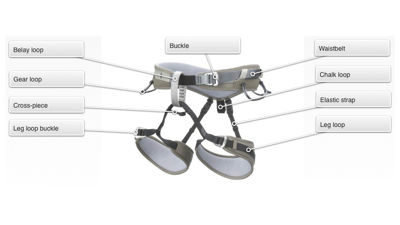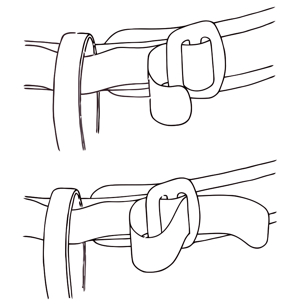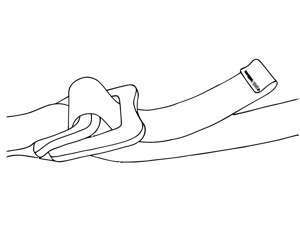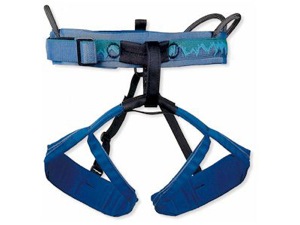Climbing harness is made of several interconnected loops of webbing that spans the body and is used for hanging of a person into heights and above free depths. It gradually evolved from harnesses attached directly by the end of the rope to the body of the climber. That was not comfortable, so eventually started to be used various harness designs made of knotted straps, belts and bandages. Finally the development came to a construction of sewn webbing harnesses as we know it today. Currently are identified three basic types of harness – a) seat harness, b) chest harness, c) full-body harness. By combining of seat and chest harness is created another type – combined harness. Harnesses are also produced specialized for a specific activity, so we can hear expressions like Alpine harness, caving harness or work harness for construction and industrial use.
Seat harness
Warning at the beginning. During the use of seat harness alone is the tying point below the centre of gravity of human body, which may during an uncontrolled fall lead to an overturning of body upside down.

The most frequent type of seat harness is designed so that it spans the hips and thighs. It consists of waistbelt and two leg loops connected by strap. This strap connecting two leg loops is connected with waistbelt by massive eye (so called belay loop). On the back is the waistbelt connected with leg loops by elastic straps (they have no load-bearing function) and their purpose is to keep the leg loops up while climbing. Otherwise would leg loops dangle down and restrict the movement of climber. Waistbelt can be unfastened by metal buckle. Some seat harnesses have these buckles also on leg loops. Buckles should be made of lightweight but strong alloy so they would not present unnecessary burden. It is also good if the buckles are painted with some insulating coating (paint) so the fingers would not freeze to them in a cold weather (after a climber pulls out the hands from dump gloves for easier handling). The most common design of buckle is one metal piece and the strap is threaded three times through. First, from the bottom upwards, then top to bottom and after going over the side of the buckle back through the first hole from top to bottom again. At the end must be strap in the buckle tightly secured. Protruding end of strap should be long at least three times the width of a strap, but usually approx. 20 cm. It is good to have longer strap at least during the winter, when a climber wears thick clothing – then he/she does not have a problem with buckling up. During buckling of seat harness it is necessary to be concentrated on the task, always check the results, preferably with other climbers. It’s hard to believe, but it has happened many times that people have forgotten to buckle their waistbelt, and went for the ascent. It is somewhat frightening to find out several meters above the ground, when you cannot let go of you hands, that you harness is not buckled.


More modern version is so called quick-fastening buckle, sometimes also called QB (Quick Band). Strap is threaded through this buckle only two times. Part of the strap always stays in the buckle; strap is loosened only when it is necessary to putt the harness on or off. End of the strap has to be widened or otherwise fixed to prevent its slippage through the buckle. After putting seat harness on we pull at the strap and tighten it in the quick-fastening buckle.

On the sides of waistbelt there are gear loops, used for carrying of climbing gear. They are mostly made of thin, relatively strong rope, on which is threaded rubber tube. This rubber tube should be thicker then a cut-out in the carabiner’s notch (therefore thicker more then approx. 6 mm). Carabiners then do not tend to get caught after pulling out of the loop. There are seat harnesses with gear loops made only by a rope or also by nonflexible plastic eye.
Gear loops are sometimes sewn to the waistbelt as if upside down. It is so on purpose. They are upside down only when they are empty. Once there is even a single carabiner clipped into them, they will bend down. But even after bending down they stick out from a waistbelt a little and it is therefore easier to clip (and unclip) the carabiners into them.

Hint: Seat harness with wide waistbelt has one disadvantage. Waistbelt of seat harness interferes with waistbelt of backpack (if you wear backpack during the climb). Therefore it is good to have backpack with waistbelt seated in a way that ensures minimal overlapping with waistbelt of seat harness. You need to try it right in the store or at least before the event. You will be saved an uncomfortable experience.
Continued in the book >>

